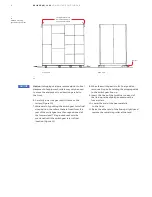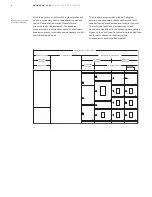
25
R E LI AG E A R® LV SG
LO W VO LTAG E S W I TC H G E A R
Figure 37 illustrates the various components
comprising the vertical main bus bars. Bus bars are
supported by molded or machined barriers. Vertical
bus can be braced depending on the interrupting
rating of the switchgear. Conductors that provide
current to the breaker compartments are called
run in bars and are bolted to the riser bus bars.
Insulated run back bars are for connecting load
conductor cabling.
1. Molded base
2. Vertical riser buses
(cover removed to show bus location)
3. Vertical bus bracing
4. Run in conductors
5. Insulated run backs
1. Vertical bus barrier
2. Insulated bus bar (epoxy coated)
3. Joint cap
4. Nylon thumb screw
—
36
Bus system
—
37
—
36
—
37
Insulated horizontal
bus system
4
5
1
2
3
2
4
1
3
Feeder cable and busway
The rear cable and terminal compartment, Figure 38
provides for cable installation and terminations.
The cable bending space meets the requirements
of the National Electric Code. Various arrangements
of single or double cable terminals are provided,
depending upon the purchaser's requirements.
When specified, racks for the support of feeder
cables are located in the cable compartment. The
actual support of the cables is provided by lashing
them to these racks.
Also located in the cable compartments are
provisions for terminating control wires between
external devices and control circuits within the
switchgear equipment. Figure 39 shows this typical
arrangement.
1. Cable lugs (mechanical type)
When furnished, the terminal boards, Figure 39,
for such connections are located in an enclosed
vertical wiring trough mounted on the side of
the cable compartment. The trough is of steel
construction with bolted covers to provide an
isolation barrier between the control wiring
and the adjacent power cables.
—
38
Cable termination
provisions
—
38
1
















































